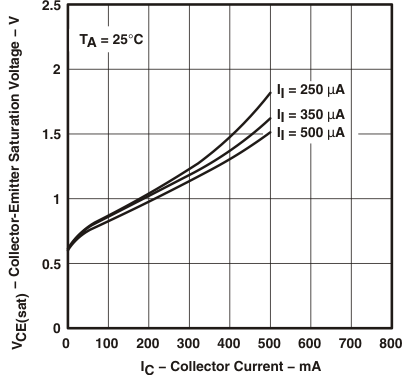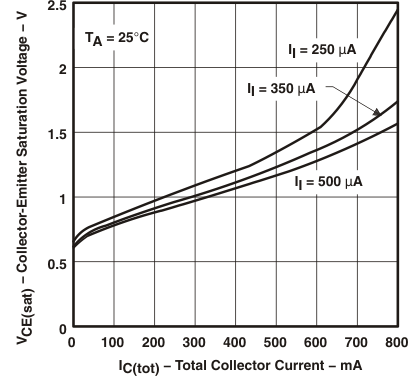SGLS148E December 2002 – December 2015 ULQ2003A-Q1 , ULQ2004A-Q1
PRODUCTION DATA.
- 1 Features
- 2 Applications
- 3 Description
- 4 Revision History
- 5 Pin Configuration and Functions
-
6 Specifications
- 6.1 Absolute Maximum Ratings
- 6.2 ESD Ratings
- 6.3 Recommended Operating Conditions
- 6.4 Thermal Information
- 6.5 Electrical Characteristics, ULQ2003AT and ULQ2003AQ
- 6.6 Electrical Characteristics, ULQ2004AT
- 6.7 Switching Characteristics, ULQ2003A and ULQ2004A
- 6.8 Dissipation Ratings
- 6.9 Typical Characteristics
- 7 Parameter Measurement Information
- 8 Detailed Description
- 9 Application and Implementation
- 10Power Supply Recommendations
- 11Layout
- 12Device and Documentation Support
- 13Mechanical, Packaging, and Orderable Information
Package Options
Refer to the PDF data sheet for device specific package drawings
Mechanical Data (Package|Pins)
- D|16
Thermal pad, mechanical data (Package|Pins)
- D|16
Orderable Information
6 Specifications
6.1 Absolute Maximum Ratings
at 25°C free-air temperature (unless otherwise noted)(1)| MIN | MAX | UNIT | |||
|---|---|---|---|---|---|
| VCE | Collector-emitter voltage | 50 | V | ||
| Clamp diode reverse voltage(2) | 50 | V | |||
| VI | Input voltage(2) | 30 | V | ||
| Peak collector current | See Figure 16 | 500 | mA | ||
| IOK | Output clamp current | 500 | mA | ||
| Total emitter-terminal current | –2.5 | A | |||
| PD | Continuous total power dissipation | See Dissipation Ratings | |||
| TA | Operating free-air temperature | ULQ200xAT | –40 | 105 | °C |
| ULQ200xAQ | –40 | 125 | |||
| TJ | Junction temperature | 150 | °C | ||
| Tstg | Storage temperature | –65 | 150 | °C | |
(1) Stresses beyond those listed under Absolute Maximum Ratings may cause permanent damage to the device. These are stress ratings only, and functional operation of the device at these or any other conditions beyond those indicated under Recommended Operating Conditions is not implied. Exposure to absolute-maximum-rated conditions for extended periods may affect device reliability.
(2) All voltage values are with respect to the emitter/substrate terminal E, unless otherwise noted.
6.2 ESD Ratings
| VALUE | UNIT | |||||
|---|---|---|---|---|---|---|
| V(ESD) | Electrostatic discharge | Human-body model (HBM), per AEC Q100-002(1) | ±2000 | V | ||
| Charged-device model (CDM), per AEC Q100-011 | ±500 | |||||
(1) AEC Q100-002 indicates HBM stressing is done in accordance with the ANSI/ESDA/JEDEC JS-001 specification.
6.3 Recommended Operating Conditions
over operating free-air temperature range (unless otherwise noted)| MIN | MAX | UNIT | ||
|---|---|---|---|---|
| VCE | Collector-emitter voltage | 0 | 50 | V |
| TJ | Junction temperature | –40 | 125 | °C |
6.4 Thermal Information
| THERMAL METRIC(1) | ULQ2003A-Q1, ULQ2004A-Q1 | ULQ2003A-Q1 | UNIT | |
|---|---|---|---|---|
| D (SOIC) | PW (TSSOP) | |||
| 16 PINS | 16 PINS | |||
| RθJA | Junction-to-ambient thermal resistance | 73 | 108 | °C/W |
(1) For more information about traditional and new thermal metrics, see the Semiconductor and IC Package Thermal Metrics application report, SPRA953.
6.5 Electrical Characteristics, ULQ2003AT and ULQ2003AQ
over recommended operating conditions (unless otherwise noted)| PARAMETER | TEST CONDITIONS | MIN | TYP | MAX | UNIT | |||
|---|---|---|---|---|---|---|---|---|
| VI(on) | On-state input voltage | VCE = 2 V, see Figure 10 | IC = 200 mA | 2.7 | V | |||
| IC = 250 mA | 2.9 | |||||||
| IC = 300 mA | 3 | |||||||
| VCE(sat) | Collector-emitter saturation voltage | II = 250 μA,IC = 100 mA, see Figure 9 | ULQ2003AT | 0.9 | 1.2 | V | ||
| ULQ2003AQ | 1 | 1.3 | ||||||
| II = 350 μA,IC = 200 mA, see Figure 9 | ULQ2003AT | 1 | 1.4 | |||||
| ULQ2003AQ | 1 | 1.5 | ||||||
| II = 500 μA,IC = 350 mA, see Figure 9 | ULQ2003AT | 1.2 | 1.7 | |||||
| ULQ2003AQ | 1.2 | 1.8 | ||||||
| ICEX | Collector cutoff current | VCE = 50 V, II = 0, see Figure 3 |
TA = 25°C | 100 | μA | |||
| TA = 105°C, ULQ2003AT | 165 | |||||||
| VF | Clamp forward voltage | IF = 350 mA, see Figure 8 | 1.7 | 2.2 | V | |||
| II(off) | Off-state input current | VCE = 50 V, IC = 500 μA, see Figure 5 | 30 | 65 | μA | |||
| II | Input current | VI = 3.85 V, see Figure 6 | 0.93 | 1.35 | mA | |||
| IR | Clamp reverse current | VR = 50 V, TA = 25°C, see Figure 7 | 100 | μA | ||||
| Ci | Input capacitance | VI = 0, f = 1 MHz | 15 | 25 | pF | |||
6.6 Electrical Characteristics, ULQ2004AT
over recommended operating conditions (unless otherwise noted)| PARAMETER | TEST CONDITIONS | MIN | TYP | MAX | UNIT | ||
|---|---|---|---|---|---|---|---|
| VI(on) | On-state input voltage | VCE = 2 V, see Figure 10 | IC = 125 mA | 5 | V | ||
| IC = 200 mA | 6 | ||||||
| IC = 275 mA | 7 | ||||||
| IC = 350 mA | 8 | ||||||
| VCE(sat) | Collector-emitter saturation voltage | II = 250 μA, IC = 100 mA, see Figure 9 | 0.9 | 1.1 | V | ||
| II = 350 μA, IC = 200 mA, see Figure 9 | 1 | 1.3 | |||||
| II = 500 μA, IC = 350 mA, see Figure 9 | 1.2 | 1.6 | |||||
| ICEX | Collector cutoff current | VCE = 50 V, II = 0, See Figure 3 |
TA = 25°C | 50 | μA | ||
| TA = 105°C | |||||||
| VCE = 50 V, see Figure 4 | II = 0 | 100 | |||||
| VI = 1 V | 500 | ||||||
| VF | Clamp forward voltage | IF = 350 mA, see Figure 8 | 1.7 | 2.1 | V | ||
| II(off) | Off-state input current | VCE = 50 V, IC = 500 μA, see Figure 5 | 50 | 65 | μA | ||
| II | Input current | VI = 5 V, see Figure 6 | 0.35 | 0.5 | mA | ||
| VI = 12 V, , see Figure 6 | 1 | 1.45 | |||||
| IR | Clamp reverse current | VR = 50 V, see Figure 7 | TA = 25°C | 50 | μA | ||
| TA = 105°C | 100 | ||||||
| Ci | Input capacitance | VI = 0, f = 1 MHz | 15 | 25 | pF | ||
6.7 Switching Characteristics, ULQ2003A and ULQ2004A
over recommended operating conditions (unless otherwise noted)| PARAMETER | TEST CONDITIONS | MIN | TYP | MAX | UNIT | |
|---|---|---|---|---|---|---|
| tPLH | Propagation delay time, low- to high-level output | See Figure 11 | 1 | 10 | μs | |
| tPHL | Propagation delay time, high- to low-level output | See Figure 11 | 1 | 10 | μs | |
| VOH | High-level output voltage after switching | VS = 50 V, IO = 300 mA, See Figure 12 | VS – 500 | mV | ||
6.8 Dissipation Ratings
| PACKAGE | TA = 25°C POWER RATING |
DERATING FACTOR ABOVE TA = 25°C | TA = 85°C POWER RATING |
TA = 105°C POWER RATING |
TA = 125°C POWER RATING |
|---|---|---|---|---|---|
| D | 950 mW | 7.6 mW/°C | 494 mW | 342 mW | 190 mW |
6.9 Typical Characteristics

